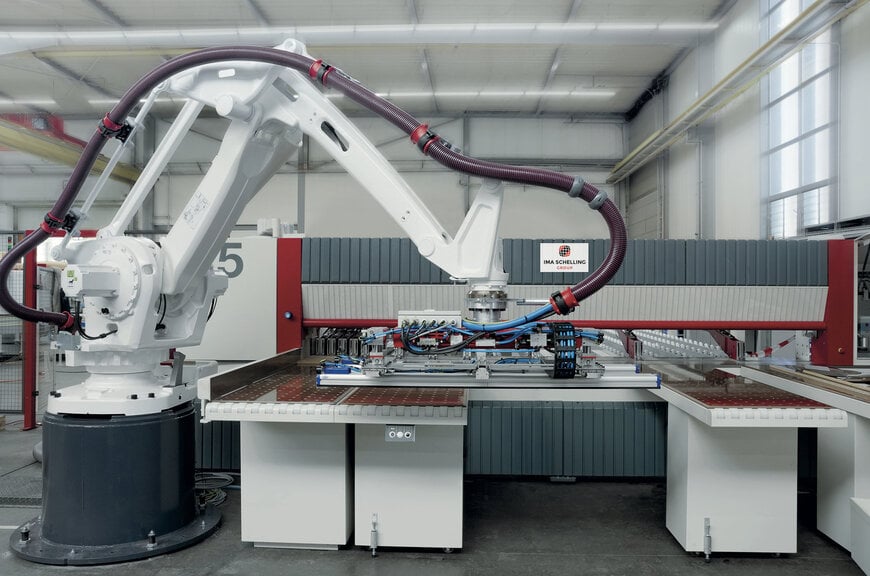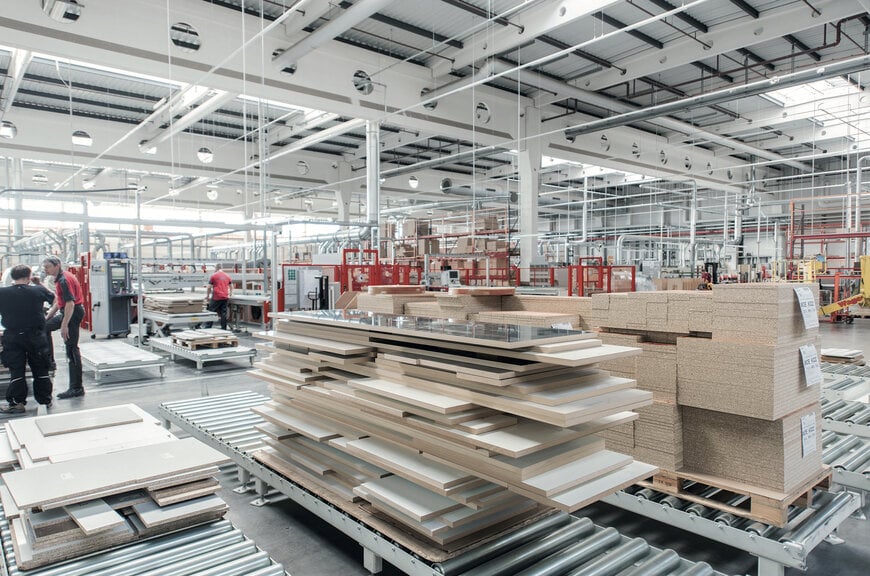www.ptreview.co.uk
09
'25
Written on Modified on
IMA Schelling Automates Furniture Production with Robotic Vision System
IMA Schelling's Robot.work solution uses 2D/3D vision and a dynamic stacking algorithm to automate board handling and palletizing for furniture manufacturing.
www.imaschelling.com

IMA Schelling's Robot.work enables automated handling of strips and finished parts with the fh 4 and fh 5 saws.
A combination of cameras, software and robots creates a highly efficient three-way solution that allows for efficient board handling and stable stacking. By opting for automated handling solutions from IMA Schelling, customers can boost efficiency and precision in production.
How can I get extremely heavy workpieces into the machining cycle and back out again? I need an efficient way to stack finished parts in stable stacks – how can I do this? And how can I make part tracking as fast as possible? These three questions all have the same answer: robotics.
Automated board cutting
The IMA Schelling Group creates the conditions for automated operation of your cut-to-size saws fh 4 and fh 5 with its Robot.work automation solution. A robot picks up the cut strips and finished parts, turns them for further processing and removes them again. Based on this approach, up to 800 parts can be processed per shift with only minimal production staff. The finished parts can be transported further along a straight or angled chain or stacked on pallets on the ground. IMA Schelling offers two standard layouts for this, with the parts stacked straight on or to the side.
Hand and eye
If the robot is the "hand" that grasps the parts, the Vision System is the "eye" that perceives their presence. Developed in collaboration with Optonic, IMA Schelling's new Vision System uses two cameras and a data connection to quickly and reliably identify the workpieces in chaotic stacks. A 3D camera "sees" the workpieces while a 2D camera scans labels and bar codes so the system can compare the information obtained with the data from production control. This allows the system to identify workpieces at rapid speed and with maximum precision.
Intelligent stacking solution
Stacks should be as compact as possible, but this is difficult when the workpieces have different dimensions. Stability and productivity are both key factors here. After all, a plant's production efficiency is limited to how quickly the workpieces are unloaded and stacked at the end. Aiming to boost performance, IMA Schelling developed an approach called dynamic stacking.

The intelligent stacking solution from IMA Schelling performs an advance stacking calculation for the entire order.
The algorithm behind the company's intelligent stacking solution performs an advance calculation for a cutting pattern or order to determine how the workpieces can be stacked to form a unit. A physics engine similar to that used in computer games and simulation programs then assesses the stability of the stacks. Ideally, they should be as high as possible but need to be stable and have a high packing density. In addition to improving system utilisation by reducing stack changeover times, the software ensures space is used more effectively and makes it easier to track down individual workpieces. Plus, it creates data consistency across the entire machining process.
One key aspect that sets IMA Schelling's stacking solution apart from many others on the market is that it not only calculates the deposit pattern in advance, but also during operation. This offers decisive advantages if, for example, a board is accidentally damaged during processing and has to be ejected. In this case, the algorithm regenerates the stack during the ongoing machining cycle. This keeps production efficient even in the event of unplanned incidents.
www.imaschelling.com
A combination of cameras, software and robots creates a highly efficient three-way solution that allows for efficient board handling and stable stacking. By opting for automated handling solutions from IMA Schelling, customers can boost efficiency and precision in production.
How can I get extremely heavy workpieces into the machining cycle and back out again? I need an efficient way to stack finished parts in stable stacks – how can I do this? And how can I make part tracking as fast as possible? These three questions all have the same answer: robotics.
Automated board cutting
The IMA Schelling Group creates the conditions for automated operation of your cut-to-size saws fh 4 and fh 5 with its Robot.work automation solution. A robot picks up the cut strips and finished parts, turns them for further processing and removes them again. Based on this approach, up to 800 parts can be processed per shift with only minimal production staff. The finished parts can be transported further along a straight or angled chain or stacked on pallets on the ground. IMA Schelling offers two standard layouts for this, with the parts stacked straight on or to the side.
Hand and eye
If the robot is the "hand" that grasps the parts, the Vision System is the "eye" that perceives their presence. Developed in collaboration with Optonic, IMA Schelling's new Vision System uses two cameras and a data connection to quickly and reliably identify the workpieces in chaotic stacks. A 3D camera "sees" the workpieces while a 2D camera scans labels and bar codes so the system can compare the information obtained with the data from production control. This allows the system to identify workpieces at rapid speed and with maximum precision.
Intelligent stacking solution
Stacks should be as compact as possible, but this is difficult when the workpieces have different dimensions. Stability and productivity are both key factors here. After all, a plant's production efficiency is limited to how quickly the workpieces are unloaded and stacked at the end. Aiming to boost performance, IMA Schelling developed an approach called dynamic stacking.

The intelligent stacking solution from IMA Schelling performs an advance stacking calculation for the entire order.
The algorithm behind the company's intelligent stacking solution performs an advance calculation for a cutting pattern or order to determine how the workpieces can be stacked to form a unit. A physics engine similar to that used in computer games and simulation programs then assesses the stability of the stacks. Ideally, they should be as high as possible but need to be stable and have a high packing density. In addition to improving system utilisation by reducing stack changeover times, the software ensures space is used more effectively and makes it easier to track down individual workpieces. Plus, it creates data consistency across the entire machining process.
One key aspect that sets IMA Schelling's stacking solution apart from many others on the market is that it not only calculates the deposit pattern in advance, but also during operation. This offers decisive advantages if, for example, a board is accidentally damaged during processing and has to be ejected. In this case, the algorithm regenerates the stack during the ongoing machining cycle. This keeps production efficient even in the event of unplanned incidents.
www.imaschelling.com

